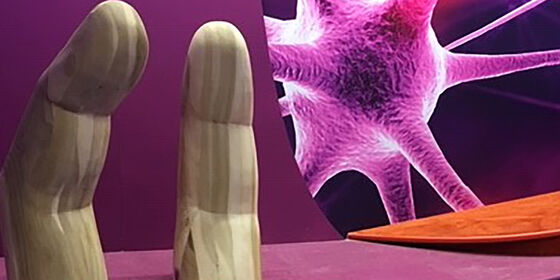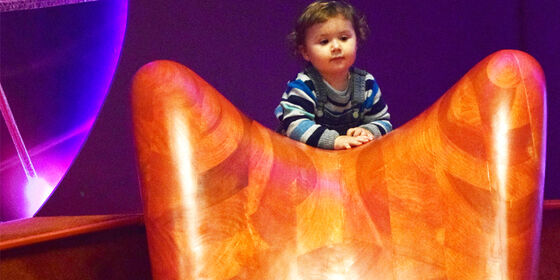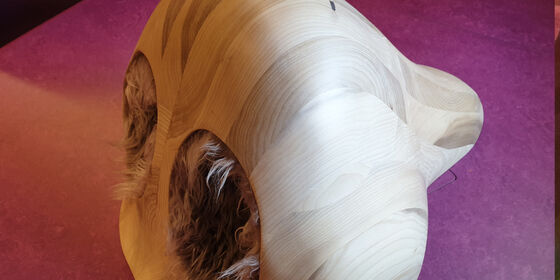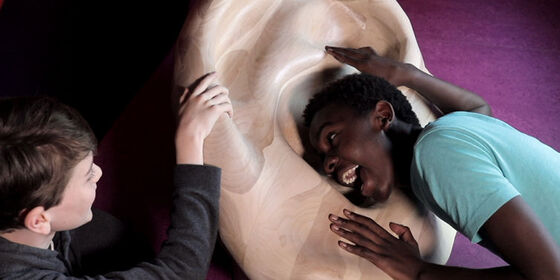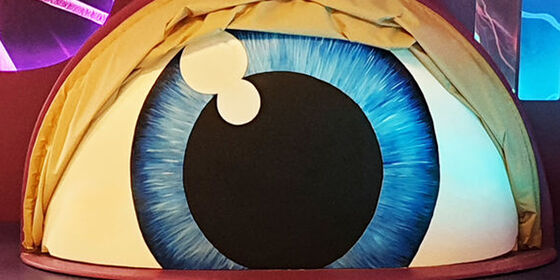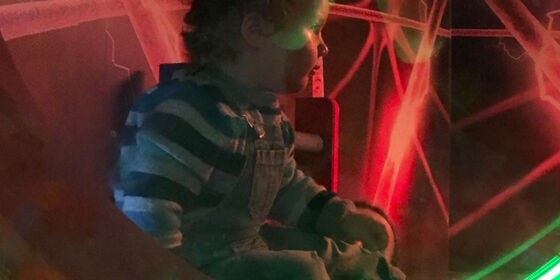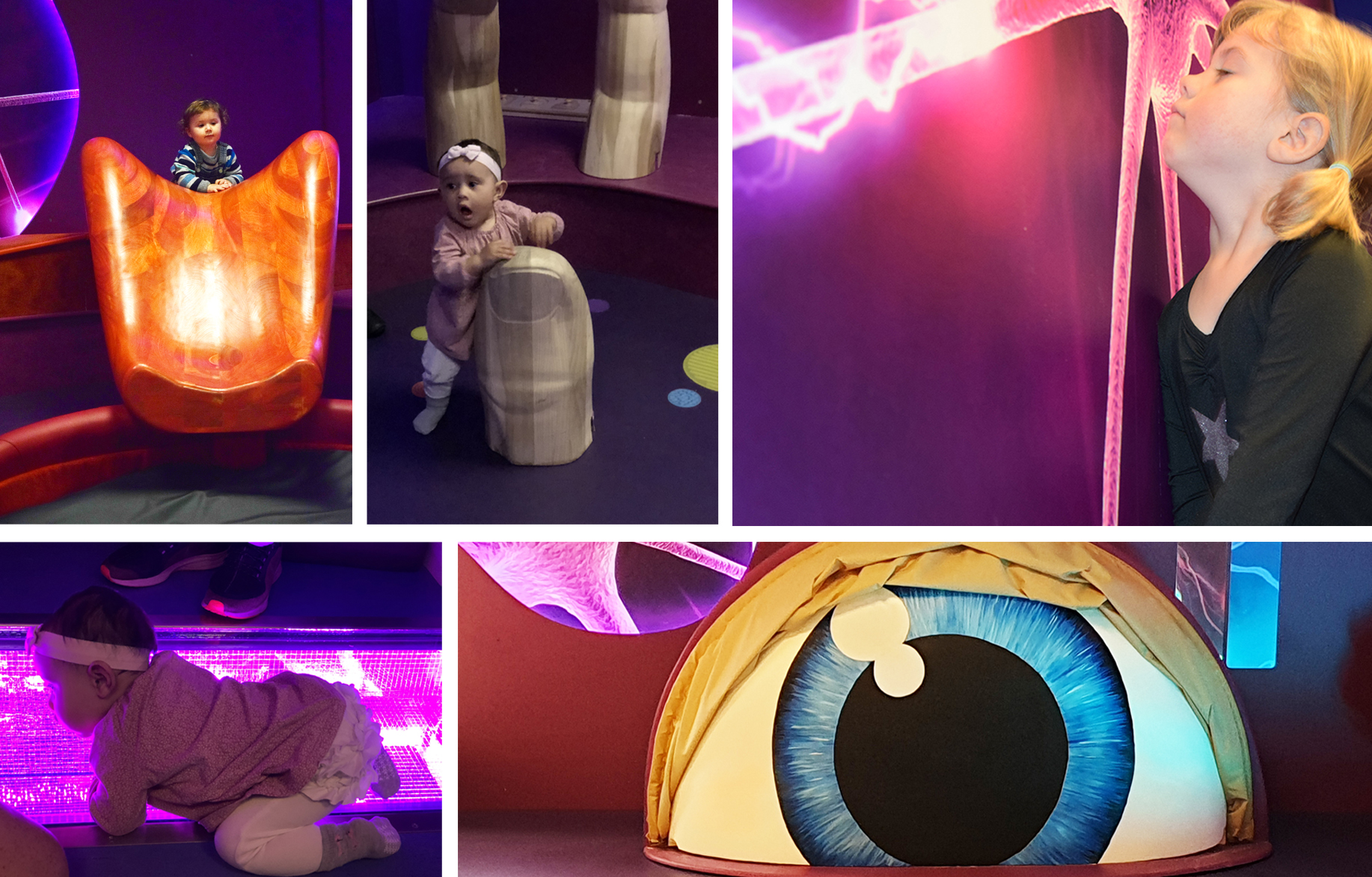
The brain links together everything your body does. It reacts to impressions from our senses and it also does things on its own such as walking, talking or eating. In the Children’s Room, the brain office is linked to the sensory stations, the eye, ear, nose, mouth and fingers. With the help of sound and light signals, children are able to communicate with the different sensory organs.
Visitors can acquaint themselves with neurons, including in cross-section, synapses and the brain’s communication with the different senses through interactivity with sculpted models of ears, fingers, tongue, eye and nose, all linked to the ‘brain office’. The room offers opportunities to touch, listen, see and experience the complexity and function of the brain and neurons.
The exhibition is designed across levels to stimulate the children’s movement. With ladders in the form of DNA strands, a slide down the tongue and different materials along the walls and floor, the children are able to orient themselves tactil, kinesthetic and visual through our exciting exhibition.
We highlight the importance of the brain’s basic needs – food, exercise and recovery – while encouraging curiosity about some of the body’s most important functions.
In our illuminated mini-exhibition about the brain, we have created good conditions for reflection. By visually exploring our 3D-printed anatomical brain models of a dinosaur (T-Rex), a hedgehog and a human being, you can quickly discover both similarities and differences between the different brains. We hope that new thoughts and ideas will emerge and that the somersaults in the brain will provide new perspectives.
The Children’s Room also offers additional creative activities that you will find in different parts of the cell walls and in the cell membrane. Memory boxes, activity boxes, wall puzzles, balance beam, songs and rhymes are some of the activities that create conditions for curiosity about science. The cell membrane is also a practical shoe rack. The proteins in the cell membrane function as pumps, receptors and transporters and regulate which substances find their way into and out of the cell.
Stations
The Tongue
When you slide down the tongue, you get a feel for how the sense of taste works. A pressure sensor in the mouth produces a sound each time you feed the body and the brain. The sensory taste cells are specialised cells on the tongue, taste buds, which can distinguish between five tastes: sour, sweet, salty, umami and bitter.
The Nose
Tickle the hairs in the nose and experience a proper sneeze. You can also explore your own sense of smell in our perfume organ and ponder how the sense of smell works. The sense of smell provides important information about food, partners, enemies and predators. The smell receptors detect odorants and send information on to parts of the cerebral cortex. There, the olfactory impulses are analysed and put together into an olfactory impression.
The Ear
Talk into the ear and follow the sound’s path via the ear canal into the auditory cortex in the temporal lobes of the cerebral cortex. The outer ear picks up soundwaves and directs these via the ear canal toward the eardrum. The vibrations are amplified via the auditory ossicles and sent to the cochlea in the inner ear. The hair cells inside the fluid-filled cochlea react to sounds of different frequencies, 20-20 000 Hz.
The Eye
Lift the eyelid and explore how the eye and sight react to light, electromagnetic radiation at wavelengths of approximately 400-700 nm. Images that appear on the retina are registered as nerve signals and it sends the impulses on via the optic nerve to the visual cortex, in the cerebral cortex’s occipital lobe, which then gives rise to a sensory impression.
The Brain Office
Climb into the brain and explore the nerve signals’ impressions at the control panel. In the brain office you can experience how the brain reacts to sensory impressions, how the impulses are processed, how the impressions affect the outgoing signals and how the body reacts.
The Brain Stem
Through the spectacularly illuminated brain stem, you will gain insight into how the impulses from nerve paths via sensory impressions between the body and the cerebrum are coordinated. Breathing and blood circulation are also regulated from here.
The Nerve Cell
Under the nerve cell, the neuron, there is an activity board to help you find the cell’s different parts and functions (printed image in cross section), e.g. the Golgi body, mitochondria, and the cell nucleus that contains the genetic material and DNA and that controls the cell’s functions. The Golgi body processes, packages and sorts the proteins while the mitochondria convert the carbohydrates into energy (cellular respiration).
The Nucleus
Next to the brain, you can exercise on a nucleus. Inside the nucleus is the cell’s genetic material, deoxyribonucleic acid (DNA) and from here, you can climb up via the DNA ladders into the brain’s other nerve cells. The genome, the genetic material, has two tasks: to carry the genetic material from one generation of cells to the next and to determine the composition and properties of the proteins and thereby the cell.
The Synapse
After actively exploring the exhibition, you have the opportunity to close yourself into and recover on the synapse swing. A nerve impulse transfers from a nerve cell to another cell via a synapse.

